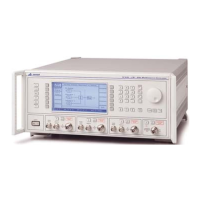TEST PROCEDURES
46882/439 7-21
(5) On the UUT set [
Φ
Mod Freq] to each of the frequencies shown in Table 7-37, measure the
deviation on the modulation meter and calculate the phase modulation for each step using
the formula in (4).
(6) Using the figure recorded in (4) as a reference, calculate the change in response at each
modulation frequency using the formula:
20 log
10
Figure recorded in (5)
Figure recorded in (4)
Check that the results are within the specifications shown in Table 7-37.
(7
) Repeat (2) to (6) for source B and, if Option 1 is fitted, source C.
Amplitude modulation
Specification
Individual outputs
For carrier frequencies <500 MHz, usable to 1.5 GHz.
Combined output
Unspecified below 5 MHz; usable to 1 MHz. Otherwise as for individual
outputs.
Range:
0 to 99.9%
Resolution:
0.1%
Accuracy:
±5% of set depth at 1 kHz modulation rate for output levels not
exceeding +10 dBm (−4 dBm at combiner output).
Bandwidth (1 dB):
DC to 30 kHz (DC coupled).
10 Hz to 30 kHz (AC coupled).
20 Hz to 30 kHz (AC coupled with ALC).
Distortion:
For modulation depths up to 30%, less than 1.5% at 1 kHz rate; for
modulation depths up to 80%, less than 2.5% at 1 kHz rate, for output
levels not exceeding +10 dBm (−4 dBm at combiner output).
ΦM on AM:
Typically 0.1 radians at 30% depth at 470 MHz.
Test equipment
Description Minimum specification Example
Modulation meter
AM accuracy ±1% at 1 kHz modulation frequency
IFR 2305 with
Distortion Option
DVM DC voltage measurement Solartron 7150+
50 Ω load
(termination)
1 W, 50 Ω nominal impedance, DC to 2.4 GHz
Lucas Weinschel
M1404N
Audio analyzer Capable of measuring THD of 0.01% from 100 Hz
to 20 kHz
Rohde & Schwarz
UPA3
Function
generator
DC to 30 kHz sine, ±0.6 dB flatness
Agilent 3325B
AM depth and distortion
Test procedure
(1) Connect the test equipment as shown in Fig. 7-9.
(2) On the UUT set source A to:
[Carrier Freq] 1.5 [MHz]
[RF Level] −4 [dB]
[AM] [AM Depth] 30 [%]
[AM ON/OFF]
(3) On the modulation meter, select CAL, AM, 300 Hz ⇒ 3.4 kHz LF filter.

